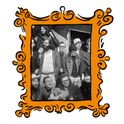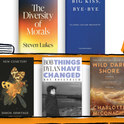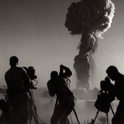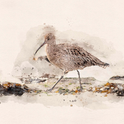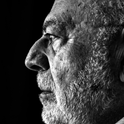The Prospect Reading Group is now an official slice of the history of the Whitechapel Gallery. The group became a live installation when 10 of us sat down recently at the large roundtable placed in the middle of the Goschka Macuga show ‘The Nature of the Beast’. We were there to discuss the exhibition and the book, Guernica: The Biography of a Twentieth-Century Icon by Gijs van Hensbergen. The group doesn't normally hold its discussions in such a public way, but plans had already been made to visit the exhibition when the table – which turned out to be explicitly set up to encourage such discussions – presented itself as an interesting experiment. As a condition of its use, the group must send the gallery notes of our meeting, for inclusion in its archive. On this occasion the discussion was joined by Hilly Janes, the new executive editor of Prospect.
At first intimidated by the echoing acoustics, the number of exhibition-goers listening in, and the size of the table (designed to evoke the UN Security Council) we gradually adjusted our voices and distances began to shrink. In front hung the Guernica Tapestry, borrowed from the UN building in New York, which reproduces the painting in softer, browner tones. Besides the tapestry and the table, which doubled up as a documentation showcase, a video showed recent scenes of devastation in Iraq and Afghanistan, and a bronze Colin Powell, the former US Secretary of State, held up a phial – the pose he took when addressing the Security Council to get backing for the second Iraq invasion. The tapestry had been covered up by blue cloth when he spoke, prompting speculation that its anti-war message was being deliberately hidden from television viewers.
There was some discussion of the morality of different types of bombing -- by drawing parallels with Iraq/Afghanistan, the artist was clearly saying that those bombings are 'bad', but couldn't she have equally chosen the Madrid terrorist train bombings of a few years ago? Is bombing different if done by a state, rather than by freelancers? Better, or worse?
We were not convinced that the installation added to the original painting, one of Pablo Picasso's most famous, which became a benchmark for the expression of political argument through art. Possibly the most travelled painting in the world, Guernica presented itself to a world audience at first hand, rather than through reproductions, something that may have given it even more influence.
What stood out for many of us was the way the painting also became a benchmark for modern art, by staying open to multiple layers of meaning. The author, Van Hensbergen, writes: 'Picasso's work, for artists, is like the theory of relativity to scientists'. It certainly shaped the aesthetics of American art, and its journey from Paris to New York symbolised the postwar shift of power in the art world. In the book, the author notes Picasso's criticisms of the Surrealists for being too narcissistic and inward-looking: Guernica arguably represents an outward stance to the world which is typical of much American highbrow culture.
Talking pictures, reading Guernica
June 01, 2009


